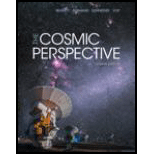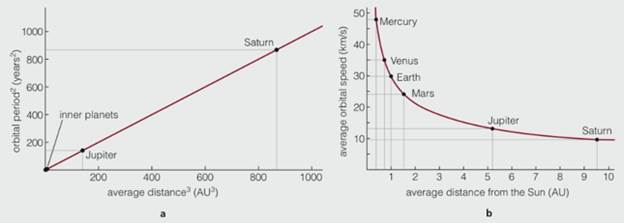
The Cosmic Perspective (8th Edition)
8th Edition
ISBN: 9780134059068
Author: Jeffrey O. Bennett, Megan O. Donahue, Nicholas Schneider, Mark Voit
Publisher: PEARSON
expand_more
expand_more
format_list_bulleted
Textbook Question
Chapter 3, Problem 3VSC
Use the following questions to check your understanding of some of the many types of visual information used in astronomy. For additional practice, try the Chapter 3 Visual Quiz at MasteringAstronomy®.

Study the two graphs above, based on Figure 3.19. Use the information in the graphs to answer the following questions.
3. Uranus, not shown on graph b, orbits about 19 AU from the Sun. Based on the graph, its approximate orbital speed is between about
a. 20 and 25 km/s.
b. 15 and 20 km/s.
c. 10 and 15 km/s.
d. 5 and 10 km/s.
Expert Solution & Answer
Want to see the full answer?
Check out a sample textbook solution
Students have asked these similar questions
Statistical thermodynamics. The number of imaginary replicas of a system of N particlesa) cannot be greater than Avogadro's numberb) must always be greater than Avogadro's number.c) has no relation to Avogadro's number.
Lab-Based Section
Use the following information to answer the lab based scenario.
A student performed an experiment in an attempt to determine the index of refraction of glass.
The student used a laser and a protractor to measure a variety of angles of incidence and
refraction through a semi-circular glass prism. The design of the experiment and the student's
results are shown below.
Angle of
Incidence (°)
Angle of
Refraction (º)
20
11
30
19
40
26
50
31
60
36
70
38
2a) By hand (i.e., without using computer software), create a linear graph on graph paper
using the student's data. Note: You will have to manipulate the data in order to achieve a
linear function.
2b) Graphically determine the index of refraction of the semi-circular glass prism, rounding your
answer to the nearest hundredth.
Use the following information to answer the next two questions.
A laser is directed at a prism made of zircon (n = 1.92) at an incident angle of 35.0°, as shown in
the diagram.
3a) Determine the critical angle of zircon.
35.0°
70°
55
55°
3b) Determine the angle of refraction when the laser beam leaves the prism.
Chapter 3 Solutions
The Cosmic Perspective (8th Edition)
Ch. 3 - Prob. 1VSCCh. 3 - Use the following questions to check your...Ch. 3 - Use the following questions to check your...Ch. 3 - Use the following questions to check your...Ch. 3 - Use the following questions to check your...Ch. 3 - Prob. 6VSCCh. 3 - Prob. 7VSCCh. 3 - Prob. 1EAPCh. 3 - Why did ancient peoples study astronomy? Describe...Ch. 3 - Describe the astronomical origins of our day,...
Ch. 3 - What is a lunar calendar? How can it be kept...Ch. 3 - What do we mean by a model in science?Ch. 3 - Summarize the development of the Greek geocentric...Ch. 3 - What was the Copernican revolution, and how did it...Ch. 3 - 8. What is an ellipse? Define its foci, semimajor...Ch. 3 - 9. State and explain the meaning of each of...Ch. 3 - Describe the three hallmarks of science and how we...Ch. 3 - 11. What is the difference between a hypothesis...Ch. 3 - What is the basic idea behind astrology? Explain...Ch. 3 - Science or Nonscience? Each of the following...Ch. 3 - Science or Nonscience? Each of the following...Ch. 3 - Science or Nonscience?
Each of the following...Ch. 3 - Science or Nonscience?
Each of the following...Ch. 3 - Science or Nonscience?
Each of the following...Ch. 3 - Science or Nonscience? Each of the following...Ch. 3 - Science or Nonscience? Each of the following...Ch. 3 - Science or Nonscience?
Each of the following...Ch. 3 - Science or Nonscience?
Each of the following...Ch. 3 - Science or Nonscience? Each of the following...Ch. 3 - In the Greek geocentric model, the retrograde...Ch. 3 - Which of the following was not a major advantage...Ch. 3 - When we say that a planet has a highly eccentric...Ch. 3 - Earth is closer to the Sun in January than in...Ch. 3 - According to Kepler’s third law, (a) Mercury...Ch. 3 - Tycho Brahe’s contribution to astronomy included...Ch. 3 - Galileo’s contribution to astronomy included (a)...Ch. 3 - Which of the following is not true about...Ch. 3 - Which of the following is not true about a...Ch. 3 - When Einstein’s theory of gravity (general...Ch. 3 - Prob. 33EAPCh. 3 - Earth’s Shape. It took thousands of years for...Ch. 3 - Prob. 35EAPCh. 3 - Prob. 36EAPCh. 3 - Prob. 37EAPCh. 3 - Prob. 38EAPCh. 3 - Prob. 39EAPCh. 3 - Prob. 40EAPCh. 3 - Prob. 41EAPCh. 3 - Prob. 42EAPCh. 3 - Prob. 43EAPCh. 3 - Prob. 44EAPCh. 3 - Be sure to show alt calculations clearly and state...Ch. 3 - Prob. 46EAPCh. 3 - Be sure to show alt calculations clearly and state...Ch. 3 - Prob. 48EAPCh. 3 - Prob. 49EAPCh. 3 - Prob. 50EAPCh. 3 - Prob. 51EAPCh. 3 - Prob. 52EAPCh. 3 - Prob. 53EAPCh. 3 - Prob. 54EAPCh. 3 - Prob. 55EAPCh. 3 - Prob. 56EAPCh. 3 - Prob. 57EAPCh. 3 - Prob. 58EAPCh. 3 - Prob. 59EAP
Knowledge Booster
Learn more about
Need a deep-dive on the concept behind this application? Look no further. Learn more about this topic, physics and related others by exploring similar questions and additional content below.Similar questions
- Use the following information to answer the next two questions. A laser is directed at a prism made of zircon (n = 1.92) at an incident angle of 35.0°, as shown in the diagram. 3a) Determine the critical angle of zircon. 35.0° 70° 55 55° 3b) Determine the angle of refraction when the laser beam leaves the prism.arrow_forwardNo chatgpt pls will upvotearrow_forwardA beam of alpha-particles of energy 7.3MeV is used.The protons emitted at an angle of zero degree are found to have energy of 9.34MeV.Find the Q-value of this reaction .arrow_forward
- An aluminum rod and a copper rod have the same length of 100cm at 5C. At what temperatures would one of the rods be 0.5 mm longer than the other? Which rod is longer at such temperature?arrow_forwardROTATIONAL DYNAMICS Question 01 A solid circular cylinder and a solid spherical ball of the same mass and radius are rolling together down the same inclined. Calculate the ratio of their kinetic energy. Assume pure rolling motion Question 02 A sphere and cylinder of the same mass and radius start from ret at the same point and more down the same plane inclined at 30° to the horizontal Which body gets the bottom first and what is its acceleration b) What angle of inclination of the plane is needed to give the slower body the same acceleration Question 03 i) Define the angular velocity of a rotating body and give its SI unit A car wheel has its angular velocity changing from 2rads to 30 rads seconds. If the radius of the wheel is 400mm. calculate ii) The angular acceleration iii) The tangential linear acceleration of a point on the rim of the wheel Question 04 in 20arrow_forwardQuestion B3 Consider the following FLRW spacetime: t2 ds² = -dt² + (dx² + dy²+ dz²), t2 where t is a constant. a) State whether this universe is spatially open, closed or flat. [2 marks] b) Determine the Hubble factor H(t), and represent it in a (roughly drawn) plot as a function of time t, starting at t = 0. [3 marks] c) Taking galaxy A to be located at (x, y, z) = (0,0,0), determine the proper distance to galaxy B located at (x, y, z) = (L, 0, 0). Determine the recessional velocity of galaxy B with respect to galaxy A. d) The Friedmann equations are 2 k 8πG а 4πG + a² (p+3p). 3 a 3 [5 marks] Use these equations to determine the energy density p(t) and the pressure p(t) for the FLRW spacetime specified at the top of the page. [5 marks] e) Given the result of question B3.d, state whether the FLRW universe in question is (i) radiation-dominated, (ii) matter-dominated, (iii) cosmological-constant-dominated, or (iv) none of the previous. Justify your answer. f) [5 marks] A conformally…arrow_forward
- SECTION B Answer ONLY TWO questions in Section B [Expect to use one single-sided A4 page for each Section-B sub question.] Question B1 Consider the line element where w is a constant. ds²=-dt²+e2wt dx², a) Determine the components of the metric and of the inverse metric. [2 marks] b) Determine the Christoffel symbols. [See the Appendix of this document.] [10 marks] c) Write down the geodesic equations. [5 marks] d) Show that e2wt it is a constant of geodesic motion. [4 marks] e) Solve the geodesic equations for null geodesics. [4 marks]arrow_forwardPage 2 SECTION A Answer ALL questions in Section A [Expect to use one single-sided A4 page for each Section-A sub question.] Question A1 SPA6308 (2024) Consider Minkowski spacetime in Cartesian coordinates th = (t, x, y, z), such that ds² = dt² + dx² + dy² + dz². (a) Consider the vector with components V" = (1,-1,0,0). Determine V and V. V. (b) Consider now the coordinate system x' (u, v, y, z) such that u =t-x, v=t+x. [2 marks] Write down the line element, the metric, the Christoffel symbols and the Riemann curvature tensor in the new coordinates. [See the Appendix of this document.] [5 marks] (c) Determine V", that is, write the object in question A1.a in the coordinate system x'. Verify explicitly that V. V is invariant under the coordinate transformation. Question A2 [5 marks] Suppose that A, is a covector field, and consider the object Fv=AAμ. (a) Show explicitly that F is a tensor, that is, show that it transforms appropriately under a coordinate transformation. [5 marks] (b)…arrow_forwardHow does boiling point of water decreases as the altitude increases?arrow_forward
arrow_back_ios
SEE MORE QUESTIONS
arrow_forward_ios
Recommended textbooks for you

 Stars and GalaxiesPhysicsISBN:9781305120785Author:Michael A. Seeds, Dana BackmanPublisher:Cengage Learning
Stars and GalaxiesPhysicsISBN:9781305120785Author:Michael A. Seeds, Dana BackmanPublisher:Cengage Learning Glencoe Physics: Principles and Problems, Student...PhysicsISBN:9780078807213Author:Paul W. ZitzewitzPublisher:Glencoe/McGraw-Hill
Glencoe Physics: Principles and Problems, Student...PhysicsISBN:9780078807213Author:Paul W. ZitzewitzPublisher:Glencoe/McGraw-Hill Foundations of Astronomy (MindTap Course List)PhysicsISBN:9781337399920Author:Michael A. Seeds, Dana BackmanPublisher:Cengage Learning
Foundations of Astronomy (MindTap Course List)PhysicsISBN:9781337399920Author:Michael A. Seeds, Dana BackmanPublisher:Cengage Learning Stars and Galaxies (MindTap Course List)PhysicsISBN:9781337399944Author:Michael A. SeedsPublisher:Cengage Learning
Stars and Galaxies (MindTap Course List)PhysicsISBN:9781337399944Author:Michael A. SeedsPublisher:Cengage Learning


Stars and Galaxies
Physics
ISBN:9781305120785
Author:Michael A. Seeds, Dana Backman
Publisher:Cengage Learning

Glencoe Physics: Principles and Problems, Student...
Physics
ISBN:9780078807213
Author:Paul W. Zitzewitz
Publisher:Glencoe/McGraw-Hill

Foundations of Astronomy (MindTap Course List)
Physics
ISBN:9781337399920
Author:Michael A. Seeds, Dana Backman
Publisher:Cengage Learning

Stars and Galaxies (MindTap Course List)
Physics
ISBN:9781337399944
Author:Michael A. Seeds
Publisher:Cengage Learning

Kepler's Three Laws Explained; Author: PhysicsHigh;https://www.youtube.com/watch?v=kyR6EO_RMKE;License: Standard YouTube License, CC-BY